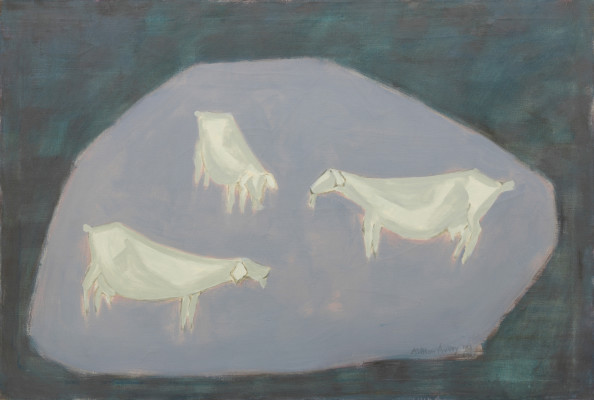The younger, abstract painters who admire Avery and have learned from him do not share his naturalism, but they see in his paintings how intensity and truth of feeling, no matter what its source, can serve to galvanize what seem the most inertly decorative elements – tenuous flatness; pure, valueless contrasts of hue; large “empty” tracts of uniform color; rudimentary simplicity of design; absence of accents – sheer, raw visual substance – into tight, dramatic, almost anecdotal unities with the traditional beginnings, middles and endings of easel painting. His example shows them how relatively indifferent the artist’s concrete means become once his formal training is finished, and how omnipotent is the force of feeling, which can body nature forth with the abstractest elements, and compel decoration to overcome and transcend itself by its own means. Clement Greenberg, “Milton Avery” in Collected Essays and Criticism vol. 4 (1993) pp. 43-44
Goat Island is based upon a gentle, 1957 drawing, White Goats. In the painting, there is no identifiable locus; the goats are set within an abstract biomorphic form – the “island” of the title. Edward Lucie-Smith wrote of Avery’s “bold abstract form(s)” decorated with recognizable, though simplified, representations of animals or people.” (2001) p. 14. And Avery once said, “I always take something out of my pictures. I strip the design to the essentials.”
Avery’s work abounds with all manner of fauna, but not all animals are the same. To elicit sentiment for the essence of “sheepness” falls well within the pastoral tradition. But there are animals whose essence is more ambivalent, more challenging. And, in taking those into his repertoire, Avery subverted the pastoral genre in the interest of art. The goat is one of those ambivalent, difficult animals, as we are reminded in his Goats and Black Goat, White Goat, both of 1951 – with their goats, opposing one another in both colour and pose. On the other hand, Avery fixes on the nature of the goat, to make it a poignant metaphor for our essential solitude, as in Forest Goat, also painted in 1957, and Lone Goat, of 1960. On Goat Island, each goat exists in its own space – they do not interact.
Publications
Milton Avery, Lunn Gallery, Washington, DC (1981). #12, back cover illustration.
Milton Avery: Figures and Symbols, Important Paintings, Fay Gold Gallery, Atlanta, GA (1985). Getlein, Frank. Milton Avery’s “Birds & Beasts” 1931-1963, Harmon-Meek Gallery, Naples, FL (1986). Illustrated p. 15.
Willers, Karl Emil. Milton Avery & The End of Modernism, Nassau County Museum of Art & Samuel Dorsky Museum of Art, Roslyn Harbor, NY & New Paltz, NY (2011). #43; listed p. 41; not illustrated.
Wajahat, Waqas. Milton Avery: The Shape of Color, Schwartz-Wajahat, New York, NY (2016). Illustrated.










































